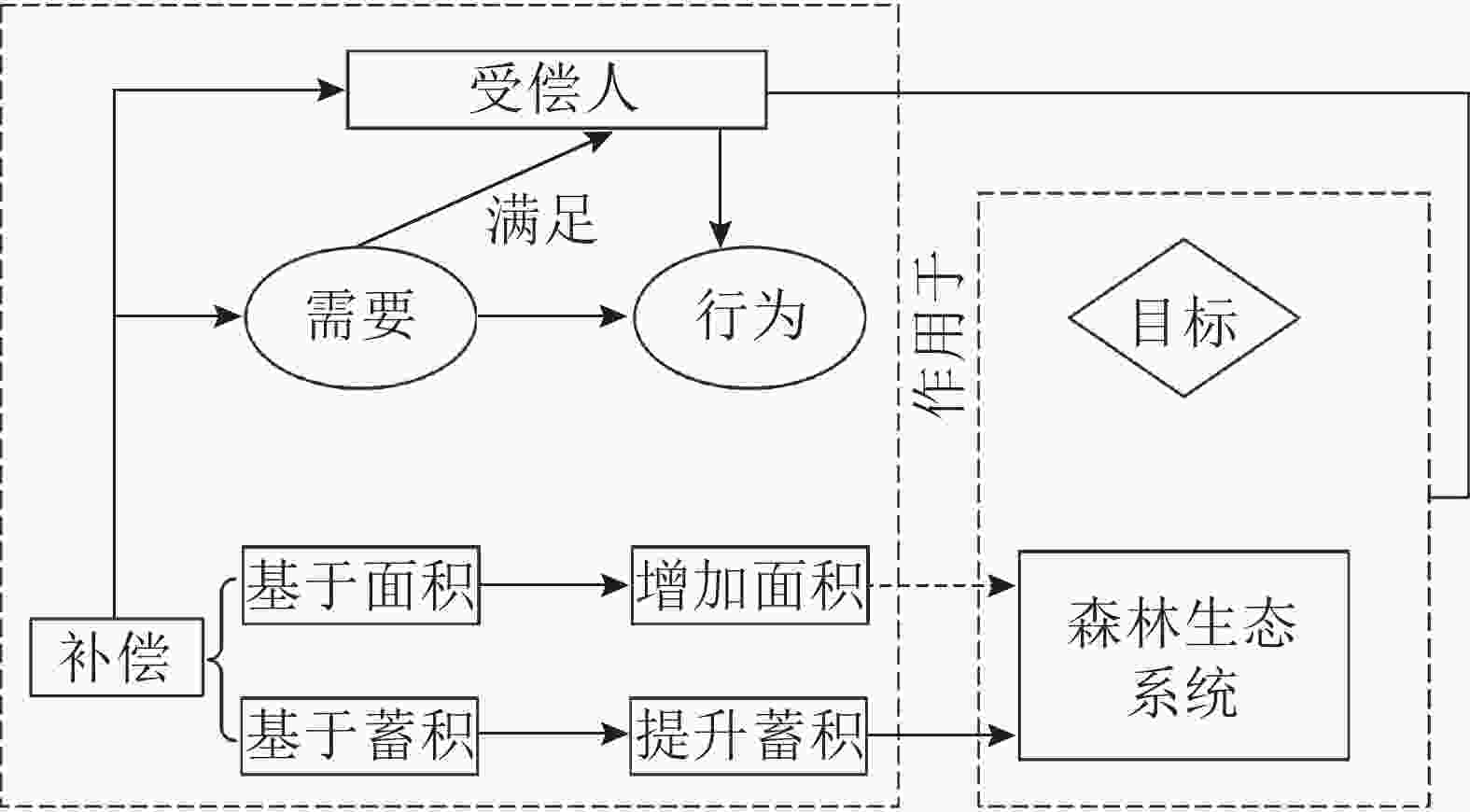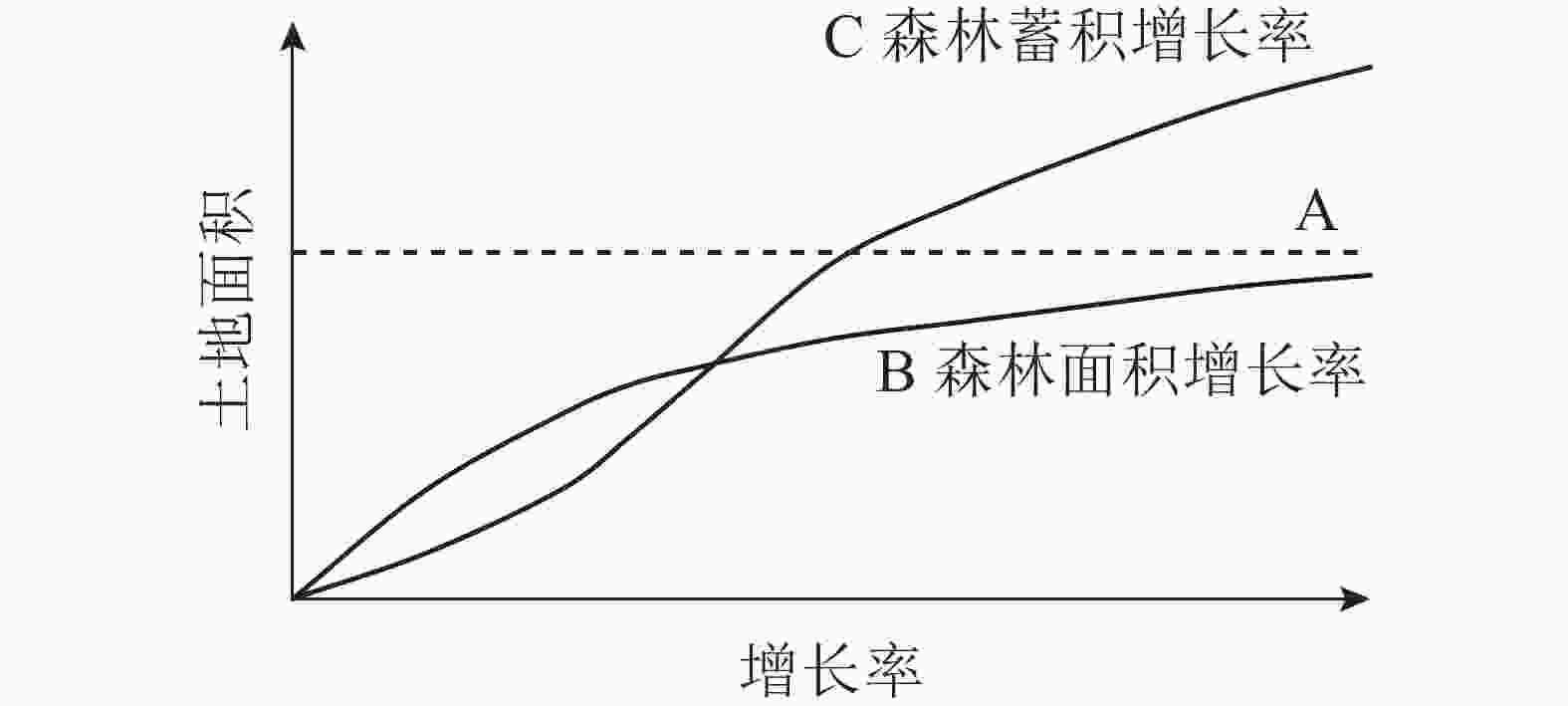-
中国森林资源稳步增长,森林面积和蓄积都有增加,但总体上仍然缺林少绿、生态脆弱,森林覆盖率仅22.96%,远低于世界平均水平(31.00%)。虽然中国森林面积总量(2.2亿hm2)位居世界第5位,但人均森林面积仅为世界水平的1/4,人均森林资源严重不足。同样,中国森林总蓄积量(175.6亿m3)位居世界前列,但人均森林蓄积仅为世界平均水平的1/7。中国乔木林蓄积量为89.79 m3·hm−2,为世界平均水平的84%,远低于北欧林业发达国家水平[1]。此外,局部地区生态破坏仍然比较严重,生态保护与代理人目标之间的矛盾始终没有得到根本性解决。人民日益增长的优美生态环境本质上需要更多优质生态产品的供给,而优质生态产品供给与森林质量的提升关系密切。
森林生态补偿是促进中国森林生态恢复和保护的一项重要制度安排,很多研究把生态补偿的依据、标准与生态服务价值紧密联系在一起,并指出生态服务价值是生态补偿的科学依据[2]。此外,在以生态服务价值作为补偿依据测算补偿标准时,大多数研究结合区域实际情况,采用条件价值法、市场价值法、非市场价值法进行补偿标准的测算[3-5]。也有学者基于生态服务价值,结合机会成本和意愿调查确定研究区域生态补偿标准[6]。学者们一致认为生态服务的机会成本是生态补偿标准的下限,生态服务价值是生态补偿标准的上限[7]。基于生态服务价值补偿依据的研究,学术界形成了成本补偿、价值补偿、效益补偿和支付意愿补偿等各种观点,但到目前为止并没有建立起一个完善的、公认的核算标准体系。标准化的缺乏以及各地实际情况的巨大差异导致评价结果的可信度低、可操作性差,很难为管理或决策部门所应用[8]。在长期实践中,中国政府森林生态补偿的实践仍然主要还是基于森林面积进行补偿,生态补偿依据的理论研究和制度实践未能很好融合。
传统的基于森林面积的生态补偿虽然能一定程度上促进森林面积的增加,却无法保证森林质量的提升。森林面积和森林蓄积是衡量森林资源状况的2个基本性指标,森林质量能较好地体现森林的生态服务价值,作为与森林质量有关的森林蓄积,是实现生态补偿依据从理论到实践的关键指标。在森林质量和生态安全日益上升为国家战略的情况下,补偿依据从基于森林面积转变为基于森林蓄积显得尤为迫切。为此,本研究对现行重点公益林生态补偿依据存在的问题进行了分析,探讨了重点生态公益林生态补偿依据从面积转向蓄积的重要性以及基于森林蓄积补偿的难点和着力点,以期为重点生态公益林生态补偿依据的转变提供科学依据。
-
生态补偿源于生态平衡思想及生态学中自然生态补偿的概念,主要指自然生态系统具有自我恢复能力,即自然生态系统的“弹性”[9]。随着学者们对生态补偿问题研究的展开和不断深入,对生态补偿内涵的理解发生许多变化,从最初的自然生态补偿,渐渐演变为促进生态环境保护的经济手段和机制[10]。对生态补偿的理解和研究主要分为2个阶段,20世纪90年代前期,生态补偿更多强调的是生态环境损害者要对生态环境破坏付出的赔偿,20世纪90年代后期则更多地强调对生态环境保护行为的补偿[10]。
森林属于公共物品,具有明显的外部经济性[11-12],确定合理、公平的森林生态补偿依据和补偿标准对森林恢复有着重要意义。政策学视角认为,森林生态补偿是一种解决生态系统服务外部性所导致的资源配置效率和公平的政策手段,是提高地区森林生态建设的积极性,维护林地所有者合法经济利益,促进经济发展和实现生态保护“双赢”的关键性措施[12-13]。经济学视角对森林生态补偿概念的界定可以划分为:基于科斯的产权交易理论、庇古的征税或补贴理论,以及既非科斯又非庇古的激励补偿机制[14-16]。法学视角对森林生态补偿的概念界定为:为缓和森林生态环境所受到的干扰,受益主体(受益人或组织)以现金或非现金方式给予森林资源生态保护人以适当的补偿,以进一步完善森林生态环境的法律制度。
本研究认为:森林生态补偿作为生态补偿的一个类别,是以保护和可持续利用森林生态系统服务为目的,综合运用各种手段特别是经济手段协调森林保护者和受益者间的利益关系,调动地区森林保护积极性,促进地区森林恢复和保护的各种规则、激励和协调的制度安排。从以上定义可以看出:森林生态补偿的实质是对物的补偿,即对森林生态系统服务的补偿,这也是森林生态补偿的基本诉求(图1)。森林生态系统服务是其补偿的客体,但森林生态补偿在法律上又表现为对人的补偿[17],即森林生态补偿通过补偿森林生态建设及维护的主体来达到实现森林生态恢复与保护的目的,补偿受益人为森林生态补偿的主体,通过对人的保护行为的补偿,最终作用于生态系统服务的提升。
为了实现林业可持续发展,中国在森林分类的基础上提出森林分类经营,并根据森林经营的目标把森林划分为公益林和商品林。其中公益林主要指发挥生态效益和社会效益的森林、林木和林地,也称为生态公益林。生态公益林根据生态区位差异进一步划分为一般公益林和重点公益林,其中重点公益林主要指生态状况极为脆弱或生态区位极为重要的重点防护林和特种用途林。重点公益林对增强生态系统稳定性和提高生态服务功能具有重要作用,但森林生态系统的外部性和公共品特性难以通过市场实现其价值,建立科学合理的生态补偿机制不仅是重点公益林可持续经营的客观需要,也是实现生态安全战略的迫切需要。
-
中国森林生态补偿政策主要指森林生态效益补偿金制度。该项补偿金制度主要针对的是重点公益林补偿,包括国有林场经营治理的重点公益林、集体林场经营治理的公益林、自然保护区内的重点公益林、村集体所有的重点公益林、林农个人所有经营的重点公益林、其他行业和个人所有或经营的重点公益林。
重点公益林的森林生态效益补偿金制度经历了从无到有的历程(图2)[18]。1992首次提出“森林生态效益补偿制度”概念,1998年《森林法》从法律形式上明确规定森林生态补偿金制度,直到2001年中国才开始进入有偿使用森林资源生态价值的新阶段,也是森林生态补偿制度的试点阶段。此时,森林生态效益补偿基金在全国11省 (市) 进行试点,试点面积为1 333.33万hm2,涵盖重点防护林和特种用途林,补偿标准为75.0元·hm−2·a−1[19];2004年中央森林生态效益补偿基金正式建立,补偿基金涉及范围扩大至全国,补偿面积扩大了2倍,但补偿标准未变;2007年颁布《中央财政森林生态效益补偿基金管理办法》以及之后几年对该办法的不断修订都是对森林生态补偿制度的不断完善,补偿面积不断扩大,2012年补偿面积高达12 446.67万hm2;重点公益林的森林生态补偿主要包括公共管护支出和补偿性支出2个部分,其中,公共管护支出主要用于按自然保护区、水库、湿地、江河源头等区域区划的重点公益林的森林火灾与扑救、森林资源的定期定点监测及林业病虫害预防与救治的支出;补偿性支出根据不同的权属有不同的补助方式,此外补偿标准也有差异。例如,2018年国家所有的国家级公益林平均补偿标准为75.0元·hm−2·a−1,但集体和个人所有的国家级公益林补偿标准为225.0元·hm−2·a−1,其中管护性支出均为3.75元·hm−2[20]。

图 2 中国森林生态补偿金制度的发展历程及重要节点
Figure 2. Development process and important nodes of China’s forest ecological compensation fund institution
除此之外,中国很多地方政府根据当地的经济情况,通过地方财政投入进行公益林的生态补偿实践。查阅相关资料可知:广东省生态公益林补偿标准为420.0元·hm−2·a−1 (2016年),浙江省省级以上公益林提高至600.0元·hm−2·a−1 (2017年),江西省国家和省级生态公益林补偿标准统一提高到322.5元·hm−2·a−1 (2018年),江苏省公益林森林生态补偿标准为450.0元·hm−2·a−1 (2019年),福建省公益林生态补偿标准提高至345.0元·hm−2·a−1 (2020年),四川省省级公益林生态效益补偿标准提高至225.0元·hm−2·a−1 (2020年)。
森林生态效益补偿制度试点建立以来,国家对重点公益林的补偿面积扩大了将近10倍,补偿金额的力度也在加大,地方政府对生态公益林的补偿标准具有差异化,其中浙江省公益林的补偿标准最高。从现行重点公益林生态补偿的依据来看,无论是国家层面还是省级层面,对公益林的补偿依据均采用面积依据,虽然不同权属的公益林补偿标准有差别,但补偿依据却一致,即均依据面积进行补偿,按质补偿仍是空缺,使得林分质量好的公益林所有者蒙受更大的经济损失[19]。
-
森林生态补偿的初衷主要是保护和改善生态环境,传统的基于森林面积为生态补偿依据的实施,使得森林资源有所恢复,但第9次全国森林资源清查结果显示:中国乔木林平均蓄积只有94.83 m3·hm−2,为世界平均水平的86%,森林生产力依旧不高。经过查阅资料和实地走访,总结了传统基于森林面积补偿存在的问题。
-
现行公益林补偿标准根据公益林的面积确定,不考虑森林区位、生态价值和林分质量,也不考虑公益林营造、培育和管护成本。这种仅根据面积确定补偿标准的办法,使得补偿标准单一、僵化[21-22],没有考虑到生态公益林实际提供生态服务价值的差异,导致过度补偿或补偿不足,由此导致现行生态公益林补偿抹杀了公益林质量、效益上的差别,而且从根本上违反了公平、正义的价值追求。
-
以森林面积为生态补偿依据,造成补偿主体片面追求森林面积,而在增强森林的抚育和经营方面激励性不足,补偿资金分配与森林质量及生态系统服务脱节,很难激发和调动公民对公益林补偿的意愿和积极性[22-23],补偿效果将大打折扣,进而出现经济学中“劣币驱逐良币”的现象,难以有效发挥生态补偿对森林质量及生态系统服务的提升功能。
-
森林生态补偿效益基金,主要来源于政府单一补偿渠道,无法有效弥补地方生态保护成本[21, 24],市场补偿需要定量化森林生态系统服务,而森林面积的大小无法确定森林生态系统服务的多少,导致基于森林面积补偿依据与市场化补偿脱节。
总体来看,基于森林面积为补偿依据的重点公益林生态补偿标准过低,不能反映森林生态服务的价值,无法达到生态补偿的目的。基于面积进行补偿,无论从制度层面还是实践层面都属于政府补偿的范畴。中国市场化补偿的研究还处于探索阶段,而且基于生态服务价值的市场化补偿与基于面积的政府补偿无法有效衔接和融合。但就政府补偿来说,探索基于森林面积转变为森林蓄积作为补偿依据的重要性,对进一步完善重点公益林的政府补偿内容及精准提升森林质量,维护国家生态安全具有重要意义。
-
良好生态环境是最普惠的民生福祉,提供更多的优质生态产品以满足人民对优美生态环境的需要。优质生态产品供给与森林质量的提升息息相关。很多学者意识到相较于基于森林面积的生态补偿,基于森林蓄积的生态补偿更能达到森林质量的精准提升,因此,对传统的基于森林面积补偿的转变显得尤为迫切。
-
森林蓄积量是指一定面积森林中现存各种活立木的材积总量,以立方米为计算单位。值得注意的是,蓄积量有继续生长和不断蓄积之意,仅限尚未采伐的森林。森林面积是指有林地面积,由乔木树种构成,郁闭度≥0.2的林地或冠幅>10 m的林带面积。简言之,面积是二维的平面度量,蓄积是三维的立体度量。
-
森林蓄积量不仅反映林地生产力,也反映了森林资源的丰富程度,是衡量森林资源质量优劣的重要依据,更是反映国家或地区森林资源总规模和水平的基本指标之一。一般蓄积量越高,森林资源越丰富,森林生态环境越好,补偿标准也应越高[22]。此外,森林蓄积量是国家林业和草原局进行森林生态功能评价的8个主要标准之一,对于森林生态服务功能的实现具有重要作用。森林蓄积与涵养水源、保育土壤、固碳释氧、营养物积累、净化大气等生态服务功能具有正效关系[25],不仅可反映森林质量,更是生态系统质量和稳定性的重要体现。以森林蓄积量作为森林生态补偿的依据,能直接对接森林质量和生态系统服务这一补偿客体,有效实现森林生态补偿的诉求。
-
中国森林资源分布不平衡。西北、西南地区,立地条件差,因此,造林难度越大,成本投入越高,森林面积增加见效也越慢,如期实现森林面积增长目标还要付出艰巨的努力。就目前而言,很难通过耕地、海洋、荒山荒地、城市建设用地等土地类型扩大森林面积。耕地是民生之根本,且近些年来中国践行最严格的耕地保护制度,坚持耕地红线不能碰,海洋也无法用来培育森林,现在的荒山荒地基本被开发,加上城市建设用地本来就很紧张。如图3所示:中国国土面积在一定时期内是固定的,如曲线A;森林面积的初期增长速度较快,当森林面积增加到一定程度,在相对固定的土地面积约束下,增加的可能性越来越小,如曲线B。因此,再继续增加森林面积的边际成本较高,相比而言,森林蓄积是立体的,在一定的森林面积限定下,仍旧可以突破土地面积的约束,通过抚育、择伐等措施增加森林蓄积,进而提高森林生态系统服务,如曲线C。
-
公平理论属于过程型激励理论,该理论认为人们对公平的感觉取决于对投入产出比的评价。当个人的投入产出比(贡献率)高于其他人的投入产出比(贡献率)时,会自觉的增加投入。依据森林面积进行补偿时,林密林疏,木优木劣均为一个标准,这样“一刀切”式的补偿方式容易使林户产生倦怠心理,降低林户植树育树、保护森林的积极性,这样的补偿方式与生态补偿的初衷背道而驰。忽视不同的产出和服务以及耗费成本的差异性,不利于弥补差异性成本,导致同等森林面积的“生态贡献”与“生态回报”不对等,造成结构层面的非公平性。
从生态效益供给角度来看,公益林生态补偿应按照公平理论,质量好的公益林应该补偿更多,这有利于促进公益林质量的提高[12],即通常说的按质论价。把森林蓄积作为生态补偿依据,能够调动受偿主体的积极性,吸引更多主体加入森林生态资源保护的行列,实现保护森林资源的目的。根据生态效益的贡献水平进行生态补偿可以从生态效益供给角度解决公平问题。
从生产成本角度来看,由于不同林地资源要素禀赋不同,在森林生态修复过程中,林地代理人投入的成本必然会出现显著差异。森林蓄积量不仅反映自然结果,更反映代理人投入的成本和劳动耗费差异。基于森林蓄积的生态补偿,一方面,森林的疏密优劣均可通过蓄积量来反映,林户的补偿收益与森林蓄积量有关,这种方式能够最大限度实现精准补偿,也与中国按劳分配为主体的分配制度相匹配,可以弥补成本投入的公平性问题;另一方面,区分不同地区林业经营者付出的私人成本差异,使得补偿与付出的差距缩小,同时拉开地区间补偿标准的差距,对一些林业经营者进行约束,体现补偿标准公平合理,实现生态补偿制度上的资源合理配置。
-
激励的过程主要是需要与行为的连锁反应过程。生态保护主体出于获得报酬的需要,会有保护行为,政府或其他主体对该保护行为进行补偿使得生态保护主体的需要得到满足,这种满足又反馈到保护行为中(图4)。人为了达到一定需要,会采取一定的行为,这种行为会作用于目的,在这过程中,不同的补偿依据对生态补偿目标的实现程度受激励的强化方向而有所不同。激励强化理论不涉及人的内部心理过程,仅讨论需要与行为的关系,但基于不同的补偿依据,其需要与行为的结果及目标存在差异。

图 4 不同补偿依据的激励连锁过程及强化作用的差异
Figure 4. Difference of the incentive chain process and strengthening effect of different compensation basis
基于森林面积的生态补偿,其激励的结果是直接导致代理人为获取生态补偿而实施扩大森林面积的行为,进而满足代理人获得现金或实物补偿的需要。中国的森林资源呈上升态势,但森林的质量却不高,可见增加面积的行为结果与生态补偿的目标即生态系统服务的提升在很多情况下呈“脱钩”关系,森林面积大不代表森林质量高。从管理学的角度来看,原先基于森林面积的生态补偿与森林质量间的激励关系存在“激励错位”或“激励缺位”。
森林蓄积量是评价森林质量的重要指标。基于森林蓄积的生态补偿,其激励的直接结果是导致代理人为获取生态补偿,不断提升森林蓄积,补偿主体需要的满足会进一步强化其增加蓄积的行为。运用森林蓄积量作为森林生态补偿制度的补偿依据,对提高林业生产经营者参与活动的积极性具有正向作用,能够更好地缓解外部性问题,将外部效应内部化,弥补生态补偿与森林质量间的“激励错位”或“激励缺位”,真正做到对症下药,具有划时代的重要意义。
-
中央财政补偿基金是森林生态效益补偿基金的重要来源,主要用于重点公益林的营造、抚育、保护和管理。中国现行的补偿资金绝大部分来自于中央政府,补偿主体过于单一,主体单一的补偿制度稳定性较差。虽然中央政府信用高,能保证公益林补偿金的发放,但中央财政补偿基金的补偿额度很大程度上并不能弥补地方生态保护的成本,且地方政府财力悬殊,很多省份配套的公益林补偿金不能及时发放。
建立市场化、多元化生态补偿机制,被认为是引导利益相关者参与、撬动社会资本投入、构建生态补偿长效机制的必然选择和有效途径。森林生态补偿实现市场化、多元化补偿的核心在于具备市场化、多元化补偿主体[26],只有具备市场化、多元化补偿主体,才能分担共同的补偿量。其次,实现市场化、多元化生态补偿必须解决市场化、多元化补偿渠道问题,只有渠道的畅通,才能保证市场化、多元化补偿的顺畅执行。再次,生态效益补偿额度计量性及可市场化程度,是森林生态补偿实现市场化、多元化补偿的必要条件。
依据森林面积进行生态效益补偿,本质上并没有依据生态效益服务流进行确认、计量、补偿,不仅无法反映当前的生态效益,也无法反映未来的生态效益。此外,依据面积不变量更无法反映生态效益服务流的时空差异。由于基于森林面积的生态补偿并不是基于服务流,其补偿主体(收益主体)不具有多元化、市场化条件,也没有可靠计量真实的生态服务流,因此无法进行市场化、多元化补偿。依据森林蓄积进行生态效益补偿的实质是基于生态资产进行确认、计量、补偿,森林蓄积量是生态资本、社会资本以及劳动资本最终产生生态效益服务流的中介性变量。因此,以蓄积量进行补偿具备补偿主体市场化、多元化的条件。
-
在可行性方面,按面积测算的技术较为成熟,通常可以采用遥感的方法或使用定位仪精确测量森林的占地面积,测算方法相对简便,可行性高。但基于森林面积的生态补偿无法对动态的服务流进行确认,导致森林生态政府补偿与市场化补偿具有明显的分离性。作为重点公益林的生态补偿依据,森林蓄积较森林面积有巨大的进步,但也不能忽视其面临的难点。蓄积量会随着森林年龄结构和种类组成发生变化,不同森林的变化速度不同,每年的蓄积量也会发生改变,对测量所需的人力、物力、财力有更大的需求,测量和补偿难度加大,进而实际的可操作性会变差。但近几年应用激光雷达技术能够大范围、高时效、高精度测算森林相关信息,使树木蓄积量的测量研究取得了长足进步,这种技术虽然尚未在全国全面使用,但已经在部分省份进行测验,证明了其结果的准确性。此外,在生态补偿实践中,可以按全国森林资源清查的数据为依据确定补偿,5 a为1个间隔,在下一次的清查中如果有增长就再按增长的量增加补偿。
值得注意的是,每个地区气温、湿度等自然因素不同,导致树种的蓄积增量不同,不同地区的种植树种,森林利用率等因素也存在差异,因此制定以森林蓄积量为补偿标准的制度,可以有效地对不同地区的森林资源状况进行区分[27-28]。为此要在确定蓄积基准的基础上,依据不同地区确定蓄积增量的补偿额度,才能避免因地区差异造成的北方地区(蓄积增长慢)补偿少南方地区(蓄积增长快)补偿多的问题。例如,可以根据中国林业发展区划,即自然条件区(一级区)、主导功能区(二级区)和布局区(三级区)设置不同的蓄积补偿标准,每个区的内部,尤其是一级区内根据气温和降水又划分为东部季风区、西北干旱区和青藏高寒区,不同区域对蓄积量增量的补偿金额也要进行调整,以达到地区的均衡。
-
转变为基于蓄积的森林生态政府补偿归根结底要拓展到市场化补偿的方式,需要找到基于森林蓄积作为补偿依据如何由政府补偿向市场补偿融合的着力点。林分蓄积量是计算生物量的参数来源,生物量的增加表明森林固碳作用的发挥[29]。中国森林生态补偿的市场化还处在探索阶段,其中最具有操作性的市场交易项目就是森林碳汇交易,这为建立市场化生态补偿提供了渠道。单纯的蓄积量并没有直接针对服务流进行补偿,存在局限性。依据碳储量增量即碳汇进行生态效益补偿的实质是针对生态效益服务流进行补偿,不仅可以反映生态效益服务流时间及空间差异,而且具备补偿主体、渠道以及可计量的多元化、市场化条件。因此,依据碳储量增量即森林碳汇进行补偿,可以通过生态效益服务流确定收益主体,构建补偿渠道,实现市场化交易,实质上推进多元化补偿进程。基于森林蓄积作为森林生态补偿依据的当前着力点也应该是发展森林碳汇,打通生态补偿市场化渠道,培育生态补偿多元化主体,促进森林生态系统服务的市场化发展。
Change in the basis of ecological compensation for key public welfare forests from area to volume
-
摘要:
目的 探究重点公益林生态补偿依据从面积到蓄积转变的重要性、难点及着力点,为重点公益林生态补偿依据转变提供理论和技术参考。 方法 选取补偿客体的目标实现、补偿主体的激励性和补偿资金的可持续性3个维度,对重点公益林生态补偿依据从面积到蓄积转变进行对比分析。 结果 相较于以森林面积为补偿依据与补偿目标的偏差,以森林蓄积为补偿依据可以更精准地完成重点公益林补偿目标。此外,以森林蓄积为补偿依据,在激励性和市场化方面展现出独特的优越性。 结论 重点公益林生态补偿政策不仅应该根据蓄积增量确定补偿额度,而且要充分考虑蓄积量的地区化差异,推动实施基于蓄积量的差异化补偿。未来应当进一步探索基于蓄积量的市场化补偿方案,发挥市场对补偿资金的调节和分配效率。图4参29 Abstract:Objective With an exploration of the importance, difficulties and focus of the transformation from “forest area” to “forest stock volume” as the index for the ecological compensation in key public welfare forests, this study is aimed to provide theoretical and technical references for the such transformation in China. Method A three-dimensional comparative analysis of the two ecological compensation bases in key public welfare forests that involve the realization of the compensation target, the incentive of the compensation subjects and the sustainability of the compensation fund. Result Compared with “forest area”, “forest stock volume” is a more accurate index in the actualization of the compensation goal and displays unique advantages in terms of incentives and marketization. Conclusion In the formulation of the ecological compensation for key public welfare forests, the increase in forest stock volume should be the basis of the compensation and regional differences should be fully considered to ensure the execution of differentiated policies. In addition, further explores should be conducted of market-based compensation schemes based on forest stock, with full play given to the market’s efficient regulation and distribution of compensation funds. [Ch, 4 fig. 29 ref.] -
Key words:
- key public welfare forests /
- ecological compensation /
- forest area /
- forest volume /
- importance
-
-
[1] 崔海鸥, 刘珉. 我国第9次森林资源清查中的资源动态研究[J]. 西部林业科学, 2020, 49(5): 91 − 95. CUI Haiou, LIU Min. Analysis on the results of the 9th National Forest Inventory [J]. J West Chian For Sci, 2020, 49(5): 91 − 95. [2] 常兆丰, 乔娟, 赵建林, 等. 我国生态补偿依据及补偿标准关键问题综述[J]. 生态科学, 2020, 39(5): 248 − 255. CHANG Zhaofeng, QIAO Juan, ZHAO Jianlin, et al. Review on the key issues of basis and criteria of ecological compensation in China [J]. Ecol Sci, 2020, 39(5): 248 − 255. [3] COSTANZA R. Ecosystem services: multiple classification systems are needed [J]. Biol Conserv, 2008, 141(2): 350 − 352. [4] 王雯雯, 叶菁, 张利国, 等. 主体功能区视角下的生态补偿研究——以湖北省为例[J]. 生态学报, 2020, 40(21): 7816 − 7825. WANG Wenwen, YE Jing, ZHANG Liguo, et al. Research on ecological compensation from the perspective of main functional areas: a case study of Hubei Province [J]. Acta Ecol Sin, 2020, 40(21): 7816 − 7825. [5] 吴强, PENG Yuanying, 马恒运, 等. 森林生态系统服务价值及其补偿校准——以马尾松林为例[J]. 生态学报, 2019, 39(1): 121 − 134. WU Qiang, PENG Yuanying, MA Hengyun, et al. Research on the value of forest ecosystem services and compensation in a Pinus massoniana forest [J]. Acta Ecol Sin, 2019, 39(1): 121 − 134. [6] 周晨, 丁晓辉, 李国平, 等. 南水北调中线工程水源区生态补偿标准研究——以生态系统服务价值为视角[J]. 资源科学, 2015, 37(4): 792 − 804. ZHOU Chen, DING Xiaohui, LI Guoping, et al. Ecological compensation standards in the water source area of the middle route project of the South-North Water Transfer Project [J]. Resour Sci, 2015, 37(4): 792 − 804. [7] 李文华, 刘某承. 关于中国生态补偿机制建设的几点思考[J]. 资源科学, 2010, 32(5): 791 − 796. LI Wenhua, LIU Moucheng. Several strategic thoughts on China’s eco-compensation mechanism [J]. Resour Sci, 2010, 32(5): 791 − 796. [8] 李文华, 李芬, 李世东, 等. 森林生态效益补偿的研究现状与展望[J]. 自然资源学报, 2006, 21(5): 677 − 688. LI Wenhua, LI Fen, LI Shidong, et al. The status and prospect of forest ecological benefit compensation [J]. J Nat Resour, 2006, 21(5): 677 − 688. [9] 何承耕, 谢剑斌, 钟全林. 生态补偿: 概念框架与应用研究[J]. 亚热带资源与环境学报, 2008, 3(2): 65 − 73. HE Chenggeng, XIE Jianbin, ZHONG Quanlin. Ecological compensation: a conceptual framework and application [J]. J Subtrop Resour Environ, 2008, 3(2): 65 − 73. [10] 谢剑斌, 何承耕, 钟全林. 对生态补偿概念及两个研究层面的反思[J]. 亚热带资源与环境学报, 2008, 3(2): 57 − 64. XIE Jianbin, HE Chenggeng, ZHONG Quanlin. Reflection on the concept and dual dimensions of ecological compensation: a multi-discipline perspective [J]. J Subtrop Resour Environ, 2008, 3(2): 57 − 64. [11] 陈钦, 林雅秋, 黄志榕, 等. 公益林生态服务市场补偿政策研究[J]. 生态经济, 2011(1): 76 − 79. CHEN Qin, LIN Yaqiu, HUANG Zhirong, et al. Studying on ecological service market compensation policy of non-commercial forest [J]. Ecol Econ, 2011(1): 76 − 79. [12] 陈钦, 陈春婵, 陈贵松. 试论公益林生态效益的补偿措施[J]. 林业经济问题, 2001, 21(2): 83 − 90. CHEN Qin, CHEN Chunchan, CHEN Guisong. Compensational measures of ecological benefits of Public Forest [J]. Probl For Econ, 2001, 21(2): 83 − 90. [13] 刘璨. 森林生态效益补偿研究进展与我国政策实践发展[J]. 环境保护, 2018, 46(14): 14 − 19. LIU Can. Research progress of forest eco-compensation and development of policy practice in China [J]. Environ Prot, 2018, 46(14): 14 − 19. [14] 毛显强, 钟瑜, 张胜. 生态补偿的理论探讨[J]. 中国人口·资源与环境, 2002, 12(4): 38 − 41. MAO Xianqiang, ZHONG Yu, ZHANG Sheng. Conception theory and mechanism of eco-compensation [J]. China Popul Resour Environ, 2002, 12(4): 38 − 41. [15] DAILY G C. Nature’s Services [M]. Washington D C: Island Press, 1997. [16] VATN A. An institutional analysis of payments for environmental services [J]. Ecol Econ, 2010, 69(6): 1245 − 1252. [17] 沈满洪, 高登奎, 王颖. 生态经济学[M]. 2版. 北京: 中国环境科学出版社, 2016. SHEN Manhong, GAO Dengkui, WANG Ying. Ecological Economics[M]. 2nd ed. Beijing: China Environmental Science Press, 2016. [18] 梁宝君, 石焱, 袁卫国. 我国森林生态效益补偿政策的回顾与思考[J]. 中南林业科技大学学报(社会科学版), 2014, 8(5): 1 − 5. LIANG Baojun, SHI Yan, YUAN Weiguo. The retrospection and thinking of forest eco-compensation policy in China [J]. J Cent South Univ Technol Soc Sci, 2014, 8(5): 1 − 5. [19] 张颖, 金笙. 公益林生态补偿[M]. 北京: 中国林业出版社, 2013. ZHANG Ying, JIN Sheng. Ecological Compensation of Public Benefit Wood[M]. Beijing: China Forestry Publishing House, 2013. [20] 王会. 森林生态补偿理论与实践思考[J]. 中国国土资源经济, 2019(7): 25 − 33. WANG Hui. Research on theory and practice of forest ecological compensation [J]. Nat Resour Econ China, 2019(7): 25 − 33. [21] 费世民, 彭镇华, 周金星, 等. 关于森林生态效益补偿问题的探讨[J]. 林业科学, 2004, 40(4): 171 − 179. FEI Shimin, PENG Zhenhua, ZHOU Jinxing, et al. A discussion on the compensation of forest ecological benefit [J]. Sci Silv Sin, 2004, 40(4): 171 − 179. [22] 李文华, 李世东, 李芬, 等. 森林生态补偿机制若干重点问题研究[J]. 中国人口·资源与环境, 2007, 17(2): 13 − 18. LI Wenhua, LI Shidong, LI Fen, et al. Discussions on several issues of forest eco-compensation mechanism [J]. China Popul Resour Environ, 2007, 17(2): 13 − 18. [23] 刘璨, 张敏新. 森林生态补偿问题研究进展[J]. 南京林业大学学报(自然科学版), 2019, 43(5): 149 − 153. LIU Can, ZHANG Minxin. Literature review and comments on forest ecological compensation [J]. J Nanjing For Univ Nat Sci Ed, 2019, 43(5): 149 − 153. [24] 李琪, 温武军, 王兴杰. 构建森林生态补偿机制的关键问题[J]. 生态学报, 2016, 36(6): 1481 − 1490. LI Qi, WEN Wujun, WANG Xingjie. Key issues for the development of a forest ecological compensation mechanism [J]. Acta Ecol Sin, 2016, 36(6): 1481 − 1490. [25] 余新晓, 鲁绍伟, 靳芳, 等. 中国森林生态系统服务功能价值评估[J]. 生态学报, 2005, 25(8): 2096 − 2102. YU Xinxiao, LU Shaowei, JIN Fang, et al. The assessment of the forest ecosystem services evaluation in China [J]. Acta Ecol Sin, 2005, 25(8): 2096 − 2102. [26] 郑云辰, 葛颜祥, 接玉梅, 等. 流域多元化生态补偿分析框架: 补偿主体视角[J]. 中国人口·资源与环境, 2019, 29(7): 131 − 139. ZHENG Yunchen, GE Yanxiang, JIE Yumei, et al. Analysis framework of diversified watershed eco-compensation: a perspective of compensation subject [J]. China Popul Resour Environ, 2019, 29(7): 131 − 139. [27] 盛文萍, 甄霖, 肖玉. 差异化的生态公益林生态补偿标准——以北京市为例[J]. 生态学报, 2019, 39(1): 45 − 52. SHENG Wenping, ZHEN Lin, XIAO Yu. Distinct eco-compensation standards for ecological forests in Beijing [J]. Acta Ecol Sin, 2019, 39(1): 45 − 52. [28] 徐旭, 钟昌标, 李冲. 区域差异视角下森林生态补偿效果与影响因素研究[J]. 软科学, 2018, 32(7): 107 − 112. XU Xu, ZHONG Changbiao, LI Chong. Study on the forest ecological compensation effect and it’s affecting factors from the perspective of regional difference [J]. Soft Sci, 2018, 32(7): 107 − 112. [29] 刘迎春, 高显连, 付超, 等. 基于森林资源清查数据估算中国森林生物量固碳潜力[J]. 生态学报, 2019, 39(11): 4002 − 4010. LIU Yingchun, GAO Xianlian, FU Chao, et al. Estimation of carbon sequestration potential of forest biomass in China based on National Forest Resources Inventory [J]. Acta Ecol Sin, 2019, 39(11): 4002 − 4010. -

-
链接本文:
https://zlxb.zafu.edu.cn/article/doi/10.11833/j.issn.2095-0756.20210148







 下载:
下载:



